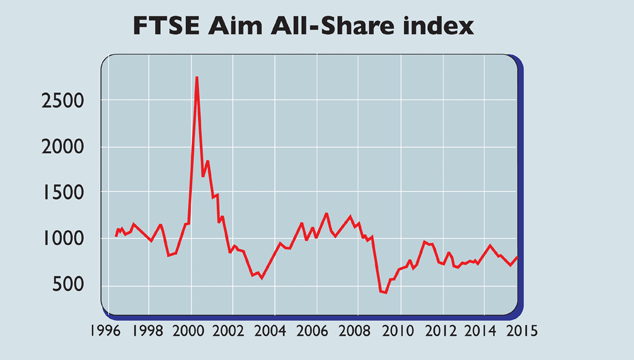Aim’s mixed record
Aim, the London Stock Exchange’s junior market for small companies, has been widely hailed as a success. But it hasn't always been like that.


Aim the London Stock Exchange's junior market for small companies, formerly known as the Alternative Investment Market was launched on 19 June 1995 and has been widely hailed as a success. Since its inception, when it had just ten companies, more than 3,580 firms have floated on it.
It currently boasts 1,100 firms worth a total of nearly £73bn. Despite ongoing criticism of its "light-touch" regulation and corporate governance problems, Aim has outlasted domestic and international rivals who grappled with similar issues.
Launched in 2005, the UK's Plus Market wound down in 2012 following financial problems and was bought by Icap. Foreign competitors, including Germany's answer to the Nasdaq, the Neuer Markt, and France's Deuxime Marche, have also disappeared.
MoneyWeek
Subscribe to MoneyWeek today and get your first six magazine issues absolutely FREE

Sign up to Money Morning
Don't miss the latest investment and personal finances news, market analysis, plus money-saving tips with our free twice-daily newsletter
Don't miss the latest investment and personal finances news, market analysis, plus money-saving tips with our free twice-daily newsletter
However, Aim's overall long-term performance has been poor, says Hardeep Tawakley in Investment Week. In the past two decades, the FTSE Aim All-Share index has fallen by around a fifth, while the blue-chip FTSE 100 has doubled. Within this headline figure, there has been great variety, thanks to small caps' volatility and unpredictability.
Notable successes include Asos, an online retailer than rose by a factor of 29 between 2008 and 2014, and Domino's Pizza, which has quadrupled in five years. But there have also been plenty of disasters, such as the high-profile flame-out in insurance IT specialist Quindell last year. Its shares have collapsed by 75% following attacks by short-sellers and controversy over share dealings by its former management.
Still, the lure of Aim hasn't been solely about growth stocks the market also offers attractive tax breaks. Holdings of qualifying Aim-listed stocks are exempt from inheritance tax once owned for two years, meaning that Aim portfolios are often used for inheritance-tax planning. Stamp duty on Aim trades was recently abolished, while shares can now be held in an Isa following a change in the law in 2013.
So what next for Aim? This year has seen the index retreat, amid uncertainty over the result of the general election. But there has been a flurry of new flotations since May, while a robust economy is typically a benign environment for small caps. Still, Aim's many burnouts are a reminder that it is "a market for stockpickers", says Tawakley. One fund with a good record is the Marlborough UK Micro Cap fund, run by Giles Hargreave.
Get the latest financial news, insights and expert analysis from our award-winning MoneyWeek team, to help you understand what really matters when it comes to your finances.

-
 8 of the best properties for sale with indoor gyms
8 of the best properties for sale with indoor gymsThe best properties for sale with indoor gyms – from a four-storey mews house in London’s Knightsbridge, to a 1920s Arts & Crafts house in Melbury Abbas, Dorset
-
 Top stock ideas for 2026 that offer solidity and growth
Top stock ideas for 2026 that offer solidity and growthLast year’s stock ideas from MoneyWeek’s columnist and trader, Michael Taylor, produced another strong performance. This year’s stocks look promising too
-
 Somero: trading this overlooked bargain
Somero: trading this overlooked bargainFeatures Mechanical-screed maker Somero dominates its niche and is attractively valued. Matthew Partridge picks the best way to trade it.
-
 How to find big profits in small companies
How to find big profits in small companiesCover Story The small- and micro-cap sectors are risky and volatile. But with careful research and patience, investors could make huge gains. Matthew Partridge explains how to find the market’s top tiddlers.
-
 The hidden gems on Aim, London's junior market
The hidden gems on Aim, London's junior marketFeatures Aim, London’s junior market, is risky – but you can find solid stocks at low prices. Scott Longley reports.
-
 Is Aim finally coming of age?
Is Aim finally coming of age?Features The Aim market of mostly smaller companies has traditionally been seen as a bit of a backwater. Is it time to change that view? Matthew Partridge talks to Paul Latham and Richard Power of fund management company Octopus.
-
Three Aim-listed firms that will thrive in a post-Brexit world
Opinion Matt Tonge and Victoria Stevens of the Liontrust UK Smaller Companies Fund pick three Aim-listed firms that will survive Brexit turmoil.
-
Fetch! The Chinese small-cap stocks to buy in the Year of the Dog
Opinion Each week, a professional investor tells us where she’d put her money. This week: Tiffany Hsiao of Matthews Asia selects three Chinese small-cap stocks with exciting potential.
-
Small and mid-cap stocks with big potential
Opinion Professional investor Guy Anderson of the Mercantile Investment Trust selects three small and medium-sized firms with promising prospects that the market has missed.
-
 Get cheap, reliable growth from smaller companies
Get cheap, reliable growth from smaller companiesFeatures One of the most reliable long-term investment trends is the long-term outperformance of smaller companies over blue chips. Max King picks some of the best ways to buy into this growth.